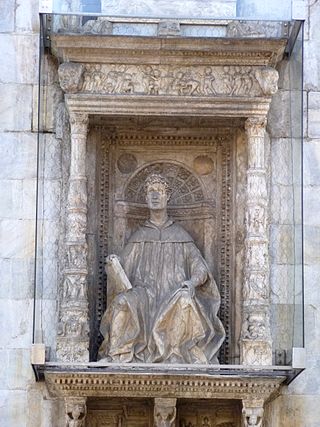
Gaius Plinius Caecilius Secundus, born Gaius Caecilius or Gaius Caecilius Cilo, better known as Pliny the Younger, was a lawyer, author, and magistrate of Ancient Rome. Pliny's uncle, Pliny the Elder, helped raise and educate him.

The Natural History is a work by Pliny the Elder. The largest single work to have survived from the Roman Empire to the modern day, the Natural History compiles information gleaned from other ancient authors. Despite the work's title, its subject area is not limited to what is today understood by natural history; Pliny himself defines his scope as "the natural world, or life". It is encyclopedic in scope, but its structure is not like that of a modern encyclopedia. It is the only work by Pliny to have survived, and the last that he published. He published the first 10 books in AD 77, but had not made a final revision of the remainder at the time of his death during the AD 79 eruption of Vesuvius. The rest was published posthumously by Pliny's nephew, Pliny the Younger.

Nicomedia was an ancient Greek city located in what is now Turkey. In 286, Nicomedia became the eastern and most senior capital city of the Roman Empire, a status which the city maintained during the Tetrarchy system (293–324).

The Teutons were an ancient northern European tribe mentioned by Roman authors. The Teutons are best known for their participation, together with the Cimbri and other groups, in the Cimbrian War with the Roman Republic in the late second century BC.

A medal or medallion is a small portable artistic object, a thin disc, normally of metal, carrying a design, usually on both sides. They typically have a commemorative purpose of some kind, and many are presented as awards. They may be intended to be worn, suspended from clothing or jewellery in some way, although this has not always been the case. They may be struck like a coin by dies or die-cast in a mould.

Tiberius Catius Asconius Silius Italicus was a Roman senator, orator and epic poet of the Silver Age of Latin literature. His only surviving work is the 17-book Punica, an epic poem about the Second Punic War and the longest surviving poem in Classical Latin at over 12,000 lines.

The art of Ancient Rome, and the territories of its Republic and later Empire, includes architecture, painting, sculpture and mosaic work. Luxury objects in metal-work, gem engraving, ivory carvings, and glass are sometimes considered to be minor forms of Roman art, although they were not considered as such at the time. Sculpture was perhaps considered as the highest form of art by Romans, but figure painting was also highly regarded. A very large body of sculpture has survived from about the 1st century BC onward, though very little from before, but very little painting remains, and probably nothing that a contemporary would have considered to be of the highest quality.

The scutum was a type of shield used among Italic peoples in antiquity, most notably by the army of ancient Rome starting about the fourth century BC.

Iaia of Cyzicus, sometimes (incorrectly) called Lala or Lalla, or rendered as Laia or Maia, was a Greek painter born in Cyzicus, Roman Empire, and relatively exceptional for being a woman artist and painting women's portraits. She was alive during the time of Marcus Terentius Varro. In De Mulieribus Claris, his book of women's biographies, Boccaccio refers to her as "Marcia", possibly confusing her with the Vestal Virgin of that name. According to Pliny the Elder: "No one had a quicker hand than she in painting".

In ancient Greek religion and myth, the Anemoi were wind gods who were each ascribed a cardinal direction from which their respective winds came, and were each associated with various seasons and weather conditions. They were the progeny of the goddess of the dawn Eos and her husband, the god of the dusk, Astraeus.
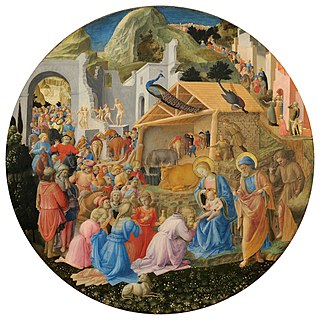
A tondo is a Renaissance term for a circular work of art, either a painting or a sculpture. The word derives from the Italian rotondo, "round." The term is usually not used in English for small round paintings, but only those over about 60 cm in diameter, thus excluding many round portrait miniatures – for sculpture the threshold is rather lower.

Nepenthes clipeata, or the shield-leaved pitcher-plant, is a tropical pitcher plant known only from the near-vertical granite cliff faces of Mount Kelam in West Kalimantan, Indonesia. It has an elevational distribution between approximately 600 and 800 m.
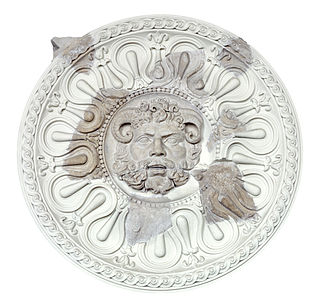
In the military of classical antiquity, a clipeus was a large shield worn by the Greek hoplites and Romans as a piece of defensive armor, which they carried upon the arm, to protect them from the blows of their enemies. It was round in shape and in the middle was a bolt of iron, or of some other metal, with a sharp point. The clipeus was more-or-less identical to the earlier aspis.
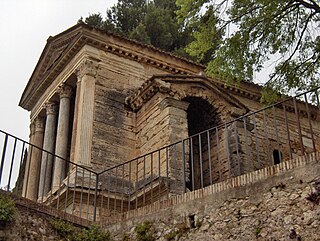
The so-called Temple of Clitumnus is a small early medieval church that sits along the banks of the Clitunno river in the town of Pissignano near Campello sul Clitunno, Umbria, Italy. In 2011, it became a UNESCO World Heritage Site as part of a group of seven such sites that mark the presence of Longobards in Italy: Places of Power.

The Epistulae are a series of personal missives by Pliny the Younger directed to his friends and associates. These Latin letters are a unique testimony of Roman administrative history and everyday life in the 1st century. The style is very different from that in the Panegyricus, and some commentators maintain that Pliny initiated a new genre: the letter written for publication. This genre offers a different type of record than the more usual history; one that dispenses with objectivity but is no less valuable for it. Especially noteworthy among the letters are two in which he describes the eruption of Mount Vesuvius in 79 during which his uncle Pliny the Elder died, and one in which he asks the Emperor for instructions regarding official policy concerning Christians.

A medallion is a round or oval ornament that frames a sculptural or pictorial decoration in any context, but typically a façade, an interior, a monument, or a piece of furniture or equipment.
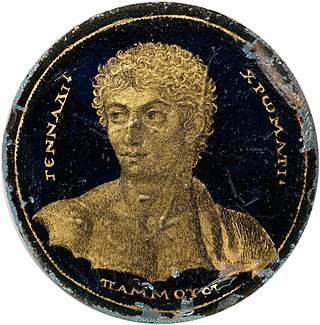
Gold glass or gold sandwich glass is a luxury form of glass where a decorative design in gold leaf is fused between two layers of glass. First found in Hellenistic Greece, it is especially characteristic of the Roman glass of the Late Empire in the 3rd and 4th century AD, where the gold decorated roundels of cups and other vessels were often cut out of the piece they had originally decorated and cemented to the walls of the catacombs of Rome as grave markers for the small recesses where bodies were buried. About 500 pieces of gold glass used in this way have been recovered. Complete vessels are far rarer. Many show religious imagery from Christianity, traditional Greco-Roman religion and its various cultic developments, and in a few examples Judaism. Others show portraits of their owners, and the finest are "among the most vivid portraits to survive from Early Christian times. They stare out at us with an extraordinary stern and melancholy intensity". From the 1st century AD the technique was also used for the gold colour in mosaics.
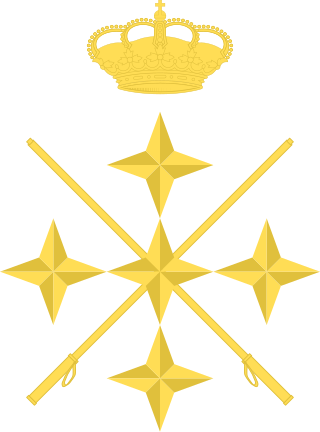
An insignia is a sign or mark distinguishing a group, grade, rank, or function. It can be a symbol of personal power or that of an official group or governing body.

In classical and late antiquity wreaths or crowns usually made of vegetation or precious metals were worn on ceremonial occasions and were awarded for various achievements. The symbolism of these different types of wreaths depended on their composition; different crowns were worn and awarded for different purposes. Such wreaths or crowns were represented in classical architecture, in ancient Greek art and sculpture, and in Roman art and sculpture. As well as being awarded for merit and military conduct, they were worn by orators, priests performing sacrifices, by the chorus in ancient Greek drama, and by attendees of a symposium.


















